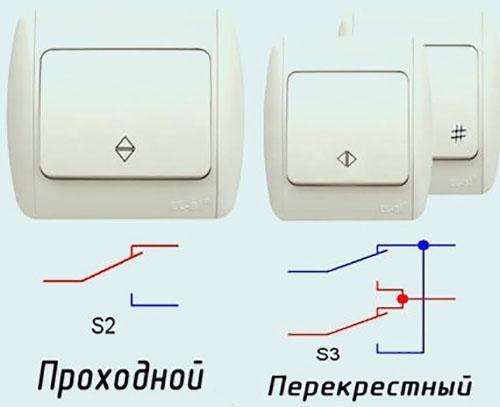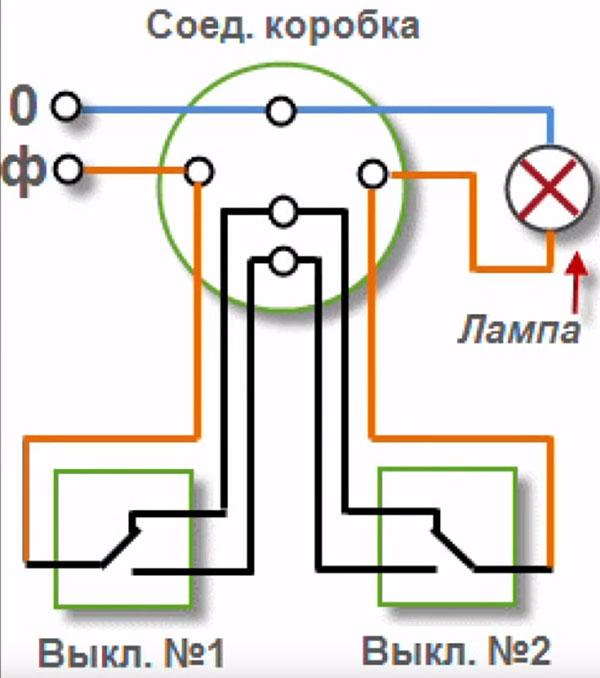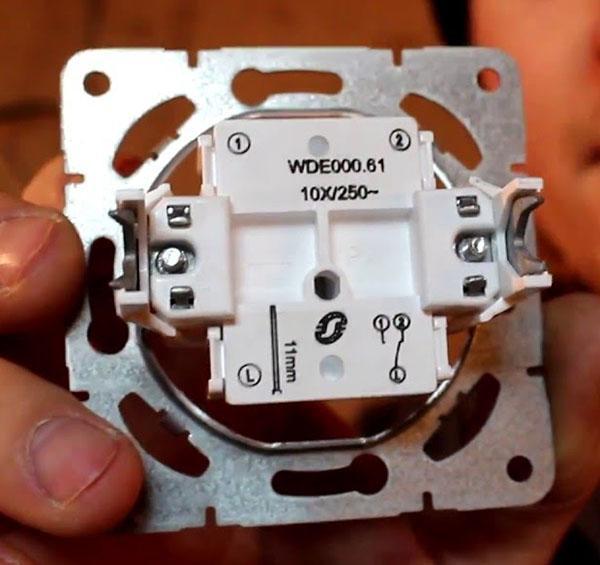How the pass-through switch works
 The light in the room must be turned on and off. There are switches for this. But a conventional switch turns on the lamps from only one place and installing a switch in parallel does not solve this problem.
The light in the room must be turned on and off. There are switches for this. But a conventional switch turns on the lamps from only one place and installing a switch in parallel does not solve this problem.
To control the lighting from two places, a pass-through switch is required. In the lighting control circuit from three places, cross switches are added to the two passages.
Device and principle of operation of pass-through switches
A walk-through switch is a device that allows you to turn on and off the light from two places and is installed in pairs, for example, at different ends of a long corridor or at the top and bottom of a staircase.
Not to be confused with a two-position switch - this is a conventional double switch in which both groups of contacts close at the same time.
How to connect a pass-through switch

- one supplies a phase to the switch or from the switch to the lamp;
- the other two connect the switches together.
When routing the wiring, one three-core cable can be used instead of three separate wires in the circuit breaker wiring diagram.
In fact, it is not a switch, but a switch. These devices do not have a defined “on” position. The phase comes to the switch, then, depending on the position of the key, is fed to one of the wires connecting the devices. The backup switch also has two positions and the outgoing wire is connected to one of the connecting wires.
If both devices are connected to one of the wires, then the circuit is closed and the lamp is on, otherwise the circuit is open and the light is turned off. Therefore, to turn the chandelier on and off, it is necessary to switch the pass-through switch to a different position.
Pass-through switch design
 Unlike a conventional switch, which has two contacts - a movable and a fixed one and two terminals for connecting wires, in pass-through switches there are three terminals and contacts - two fixed for connecting wires and one movable for connecting a phase or a chandelier.
Unlike a conventional switch, which has two contacts - a movable and a fixed one and two terminals for connecting wires, in pass-through switches there are three terminals and contacts - two fixed for connecting wires and one movable for connecting a phase or a chandelier.
Double feed-through switches are two independent constructions in one housing with six terminals. This is how they differ from conventional double switches, in which the movable contacts are connected by a built-in jumper.
How to make a pass-through light switch with your own hands
 In the absence of a pass-through switch, you can do it yourself from two conventional ones - one-key and two-key and use it instead of a pass-through switch in the circuit for switching on the light from two places. Devices must be of the same company.
In the absence of a pass-through switch, you can do it yourself from two conventional ones - one-key and two-key and use it instead of a pass-through switch in the circuit for switching on the light from two places. Devices must be of the same company.
The design of the apparatus should allow one of the moving contacts to be deployed and the fixed one to be rearranged:
- remove the two-button switch from the case;
- remove one of the moving contacts;
- dismantle the fixed contact related to the removed moving contact, turn it 180 ° and install it in place;
- install the previously removed movable contact, also turning it 180 °;
- assemble the switch and install the key from the one-button switch.
After the alteration, when the key is switched, one of the contacts will close, and the other will open.
The fixed contact can be removed from the one-key device. In this case, it does not need to be dismantled from the two-key apparatus.
Light control from three or more locations
 In addition to turning on lamps from two places, there are situations in which this is not enough. It is necessary to turn off the light from different corners of the room, in a long corridor with many doors and others. For this, cross or intermediate switches are used. Another name for this device is a reversing switch.
In addition to turning on lamps from two places, there are situations in which this is not enough. It is necessary to turn off the light from different corners of the room, in a long corridor with many doors and others. For this, cross or intermediate switches are used. Another name for this device is a reversing switch.
Switching on cross switches
 Pass-through switches are connected by two wires. If both switches are connected to one of them, then the circuit is closed and the lamp is on, otherwise it is off.
Pass-through switches are connected by two wires. If both switches are connected to one of them, then the circuit is closed and the lamp is on, otherwise it is off.
In the diagram, the cross switch is included in the gap of two wires connecting the bushings. It is called crossover because it reverses the connection of incoming and outgoing wires and the connection of pass-through switches to each other.
Such a device is connected with two pairs of wires. The number of control points can be any, and the number of cross switches is always two less - pass-through devices are installed at the beginning and end of the circuit.
Cross switch design
 In conventional, single-key devices capable of controlling only one group of lamps, 6 contacts - 2 movable and 4 fixed. Manufacturers put the scheme of the device on its back. This is done for ease of connection.
In conventional, single-key devices capable of controlling only one group of lamps, 6 contacts - 2 movable and 4 fixed. Manufacturers put the scheme of the device on its back. This is done for ease of connection.
Two- and three-key devices, capable of controlling two or three electrical devices, respectively, are two or three separate devices in one housing and have a double or triple set of contacts and terminals for connection.
A cross switch can be installed instead of a straight through. In this case, some of the terminals remain unconnected.
If no cross switch is available, a double pass switch can be installed instead. In this case, the fixed contacts are bridged in such a way that the switching pattern matches the intermediate device.
Connecting pass-through and cross-over switches
Such devices are installed similarly to conventional sockets and switches in mounting boxes or directly on the wall. The installed switches must be connected according to the diagram.
Symbols of different types of switches
On the schematic wiring diagrams, on which all the wires are applied, instead of switches, their contacts are depicted. But on single-line diagrams and a plan for the location of electrical appliances, these devices are indicated by symbols.
 An ordinary single (one-key) switch, which closes the circuit in only one position, has the form of a circle, from which an oblique line that looks like the letter "G" extends upward.
An ordinary single (one-key) switch, which closes the circuit in only one position, has the form of a circle, from which an oblique line that looks like the letter "G" extends upward.
 In the image of a double (two-key) switch, separately turning on two groups of lamps in a chandelier, there are two such lines. They are directed in different directions.
In the image of a double (two-key) switch, separately turning on two groups of lamps in a chandelier, there are two such lines. They are directed in different directions.
 The pass-through switch, which allows switching on the light from two places, is also depicted as a circle, but there are two oblique lines in the shape of the letter "L". Direct them in opposite directions.
The pass-through switch, which allows switching on the light from two places, is also depicted as a circle, but there are two oblique lines in the shape of the letter "L". Direct them in opposite directions.
 A double pass-through switch is depicted as two side by side single switches.
A double pass-through switch is depicted as two side by side single switches.
 The cross or intermediate switch has the form of a circle with four letters "G", and they are directed in different directions.
The cross or intermediate switch has the form of a circle with four letters "G", and they are directed in different directions.
Wiring
 Wires to these devices are laid with hidden wiring in grooves, and with open wiring in cable channels.
Wires to these devices are laid with hidden wiring in grooves, and with open wiring in cable channels.
Retro wiring is laid in an open way, on rollers.
The number of wires required for connection depends on the design of the device:
- to single checkpoints - 3;
- to the first double through passage (to which the phase is supplied) double - 5;
- to the second double checkpoint (to which the lamps are connected) - 6;
- 8 wires are laid to the intermediate switches for each key.
For ease of connection, it is advisable to use cables with multi-colored wires.
Pass-through and cross switches are devices that allow you to control lighting from different places.They make it more convenient for residents of the house to turn on and off the light.